Indian embroidery refers to the traditional Indian art of using materials like threads, beads, pearls, etc. to adorn different fabrics. 1
There are many types of embroidery in India and each type is intrinsic to different states and regions. The variety of Indian embroidery techniques yields gorgeous results and each technique has managed to amass a stellar fan following across the globe.
History of Indian embroidery
If one was to delve deeper into the history of Indian embroidery, he would unravel various tales and anecdotes that are entwined along the intricate threads used in Indian embroidery. As a matter of fact, Indian embroidery finds its mention in the Vedas and the first known account dates all the way back to the 5th Century BC.
Different types of Indian embroidery
Let us take you along the lanes of different Indian states to know about various kinds of famous embroidery of India:
-
Chikankari
Chikankari embroidery finds its origins in Lucknow. This traditional Indian embroidery is done on various kinds of clothes including organza, cotton, chiffon, muslin etc. Initially, this kind of embroidery was restricted to white-on-white shades but gradually it has evolved into the usage of white thread being used for embroidery on soothing and pastel-coloured garments. The process usually involves block printing the fabric with respective designs and doing thread-based embroidery work before washing. There are two main kinds of chikan kari namely mukaish geometric designs and chikan floral designs
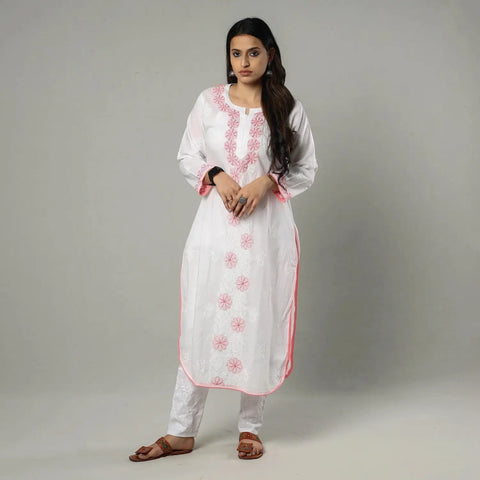
-
Zardosi
Zardosi embroidery originated from Persia and gradually made inroads into the Indian traditional fashion scene. The zardosi hand work was originally done using gold and silver threads but over the years, artisans have started using other kinds of material for the embroidery but the exquisiteness and charm of the embroidery are still maintained. Zardosi work designs are done by framing the fabric and preparing the stencil of the respective design. After that, an ari or needle is used for doing the embroidery with a lot of accuracies.
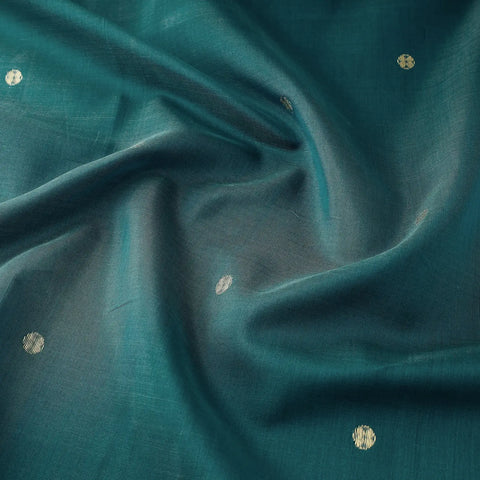
-
Aari
Aari embroidery finds its genesis in the 12th century in the Mughal era. Gradually, aari hand work became popular in Lucknow, Gujarat, Uttar Pradesh and other parts of India. Aari embroidery is done on a stretched fabric with a long needle that has a hook at the end. A small town in Andhra Pradesh known as Srikalahasti is also famous for its Aari work and their silk sarees which are adorned by this type of embroidery are very famous.
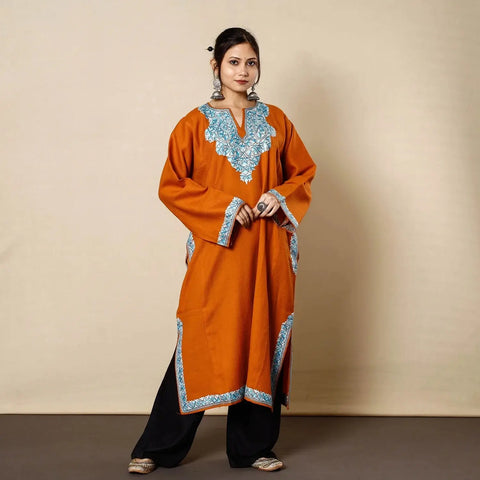
-
Banjara
Banjara embroidery designs are known for their vibrant colour patterns and pleasing designs. Traditional Banjara embroidery is characterised by the usage of coins, tassels and other embellishments to make the garment look super stunning. This type of embroidery is widely practised by the Lambada gypsy tribes of Andhra Pradesh.

-
Gota
Gota patti embroidery originated in Rajasthan and Gota embroidery is mainly done using the applique technique. The zari ribbon is intricately woven into the fabric to create exquisite and attractive patterns.
The Gota Patti and Zardosi work is especially popular during South Indian weddings for adorning formal clothes.
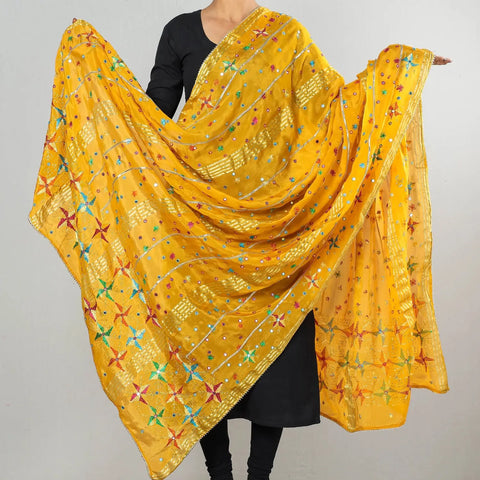
-
Kantha
Kantha embroidery originates from Bengal and this type of embroidery is especially popular in Bangladesh and the eastern regions of India. The Kantha embroidery stitches have been used by ace fashion designers to add to the popularity of this traditional embroidery of India.
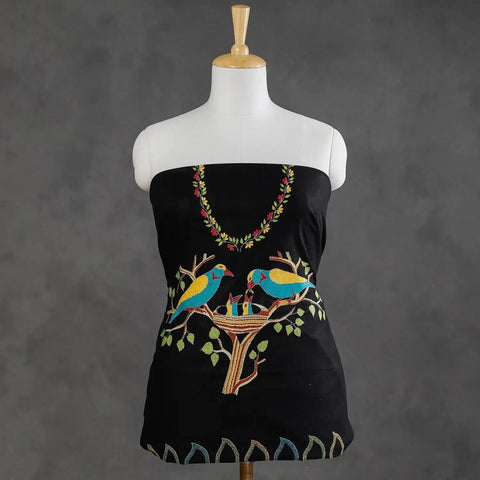
-
Phulkari
Phulkari embroidery is the folk embroidery of Punjab. The name Phulkari translates to floral but Phulkari embroidery designs also include geometrical motifs and various other patterns. This type of embroidery has a unique style where a coloured silken thread is used for embroidery on the coarse side of cotton cloth.

-
Mirror Work
Gujarat is quite famous for its mirror work embroidery. In addition to Gujarat, even Rajasthan and Orissa are famous for their designs in this particular style of embroidery. This style of embroidery is quite timeless and many ace designers have come up with stylish and contemporary renditions of this traditional form of embroidery. The Gujarati mirror work embroidery is quite popular and the Gujarati Mirror work fabric is quite sought after in fashion circles.
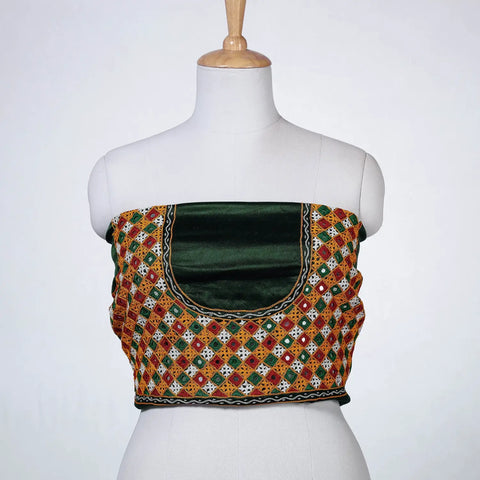
-
Toda
The toda embroidery finds its origins in Tamil Nadu and the toda embroidery products are made using the reverse stitch method. This form of embroidery design is done using the reverse stitch method. You can get stunning pieces of toda embroidery online.
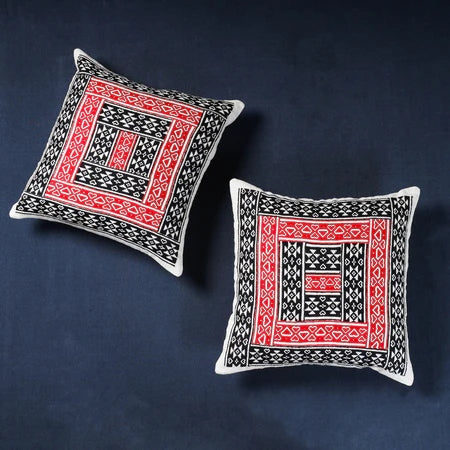
-
Kashmiri
Kashmiri embroidery is also known as kashida embroidery and it is a unique form of art that encapsulates the impeccable beauty of the beautiful state of Kashmir. Kashmiri tilla embroidery shawls are extremely popular across the globe. Kashmiri aari embroidery is another famous form of traditional embroidery that uses a pen-shaped needle for designing. 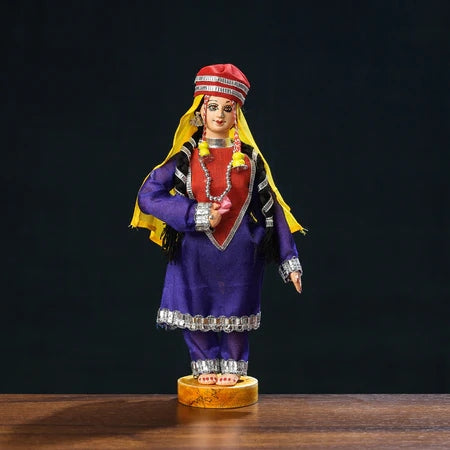
If you are in awe of these types of embroidery, wait till you read more about what different Indian states have to offer in this domain.
Famous states for traditional embroidery
We have put together a list of different types of Indian embroideries that originate from these states of India.
The culture and history of these diverse states are beautifully depicted through these types of Indian embroidery.
-
Kashmir
Sozni embroidery and Kashida embroidery are amongst the most famous types of embroidery stemming from Kashmir. Sozni is an intricate and delicate needlework embroidery which is not practised anywhere other than the paradise state of Kashmir.
-
Uttar Pradesh
Uttar Pradesh is famous for its Chikankari embroidery designs which have managed to amass a global fan base. The intricate work, ethnic appeal and gorgeousness of chikankari are a sight to behold and it looks super stunning on men and women.
-
West Bengal
The rural women of Bengal region practised Kantha embroidery which entailed the stitching of patchwork onto the fabric. This form of traditional Indian embroidery was essentially used for quilt making but over the years, this type of Indian embroidery has made its way to dupatta, saree and suit designs as well.
-
Punjab
Punjab is the land of abundance and much like the culture of this region, its phulkari embroidery is also colourful and vibrant. Punjab has a rich history which is rife with tales of courage and valour and the glory of this state extends itself to its embroidery and design as well.
-
Karnataka
Kasuti is a famous form of intricate embroidery which is practised in this state. This is a very old form of traditional Indian embroidery and the oldest known account of this type of embroidery dates back to the fifteenth century.
Hand embroidery is highly sought-after owing to its exquisiteness and cultural significance.
The artisan who does hand embroidery actually practises it like a meditation, and therefore it helps in building patience. Furthermore, traditional forms of hand embroidery are a great embodiment of our historical and cultural endowments and therefore, they act as a sublime bridge between us and our roots.
References:-
https://en.wikipedia.org/wiki/Embroidery_of_India
blogs you might also like
The journey of Indian spices
Bollywood men show how to amp up the festive look
Untold story of gifting culture
 Verified Purchase
Verified Purchase



















































































































































































































Leave a comment (all fields required)